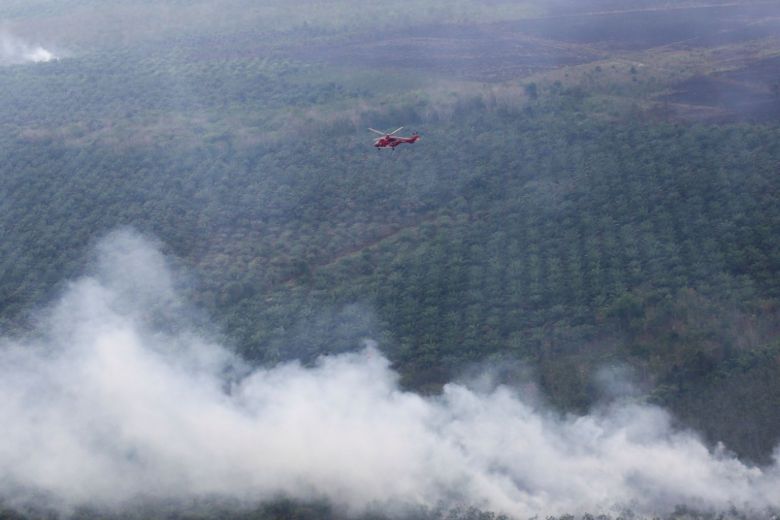AFP |
Dismissed a decade ago as far-fetched and dangerous, schemes to tame global warming by engineering the climate have migrated from the margins of policy debates towards center stage.
“Plan A” remains to tackle the problem at its source. But a major UN climate science report released in South Korea on Monday makes it clear that slashing carbon pollution even drastically won’t be enough to keep Earth from seriously overheating.
Bioenergy with carbon capture and storage (BECCS) marries a natural process with a high-tech one.
Here, then, is a menu of “Plan B” geo-engineering solutions:
Direct CO2 Capture
Experiments have shown it is possible to suck carbon dioxide directly from the air, converting it into fuel pellets or storing it underground.
A Canadian company backed by Microsoft co-founder Bill Gates launched a pilot facility in Canada in 2015, and another company unveiled one in Iceland earlier this year.
Read more: UN report:’Unprecedented’ change required for Climate change
DRAWBACK: As of now, the technology is prohibitively expensive and cannot operate at scale.
Massive Afforestation
Extensive planting of trees could significantly slow the concentration of CO2 in the atmosphere, which currently stands at more than 400 parts per million.
DRAWBACK: Even if deforestation could be reversed millions of hectares of tropical forests still disappear each year the number of trees needed to put a dent in CO2 emissions would clash with food and biofuel crops.
BECCS
Bioenergy with carbon capture and storage (BECCS) marries a natural process with a high-tech one.
One idea is to inject or spray tiny reflective particles into the stratosphere possible with balloons, aircraft or through giant tubes.
Step 1: Plant rapeseed, sugarcane, corn or “second-generation” biofuel crops such as switchgrass, which pull CO2 from the air while growing.
Step 2: While burning the harvested plants for energy sequester the CO2 produced.
The result is “negative emissions”, with less CO2 in the atmosphere than when the process started.
Virtually all climate change models projecting a future consistent with the Paris Agreement’s target of capping global warming at “well below” two degrees Celsius (3.6 degrees Fahrenheit), or 1.5C if possible, assume a key role for BECCS.
DRAWBACK: Studies calculate that upward of 40 percent of arable land twice the area of India would need to be given over to biofuel crops, putting the scheme in conflict with food crops.
Ocean Fertilization
Microscopic ocean plants called phytoplankton gobble up CO2 and drag it to the bottom of the ocean when they die.
Their colony size is limited by a lack of natural iron, but experiments have shown that sowing the ocean with iron sulphate powder creates large blooms.
Read more: Ten ways climate change can make wildfires worse
DRAWBACKS: Scientists worry about unintended impacts. Die-offs of plankton, for example, use up oxygen, which could create massive “dead zones” in the oceans, something already on the rise.
Enhanced weathering
Natural weathering of rocks a chemical process removes about one billion tonnes of CO2 from the atmosphere every year, about two percent of total man-made C02 emissions. What if technology could accelerate that process?
Spreading a powdered form of a greenish iron silicate called olivine across certain landscapes especially over the oceans and in the tropics does just that, experiments have shown.
DRAWBACKS: Enhanced weathering could probably be rapidly scaled up, but it would be expensive to mine and mill enough olivine to make a difference.
Biochar
Biochar is charcoal made by heating plant waste rice straw, peanut shells, wood scraps over long periods in low-oxygen conditions, for example, buried in the ground. It can store CO2 for long periods, and also enriches the soil.
Scientists have also calculated ways to alter clouds that could help beat the heat. One is to brighten the white, billowy ocean clouds that reflect sunlight.
DRAWBACK: The scientific jury is still out on how quickly this method could be scaled up, and on the stability of biochar used as a fertilizer.
Solar Radiation Management
Unlike other strategies, solar radiation management does not target CO2. The goal is simple: prevent some of the sun’s rays from hitting the planet’s surface, forcing them back up into space.
One idea is to inject or spray tiny reflective particles into the stratosphere possible with balloons, aircraft or through giant tubes.
Nature sometimes does the same: Debris from the 1991 eruption of Mount Pinatubo in the Philippines lowered the planet’s average surface temperature for a year or two afterward.
Read more: Mission 2018: bring the Paris climate pact to life
Scientists have also calculated ways to alter clouds that could help beat the heat. One is to brighten the white, billowy ocean clouds that reflect sunlight. Another would thin cirrus clouds, which unlike other types absorb more heat than they reflect.
DRAWBACKS: Even if it works as intended, solar radiation management would do nothing to reduce atmospheric CO2, which is making oceans too acidic. There is also the danger of knock-on consequences, including changes in rainfall patterns, and what scientists call “termination shock” a sudden warming if the system were to fail.
© Agence France-Presse














